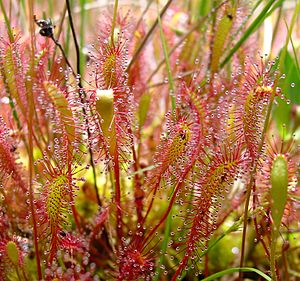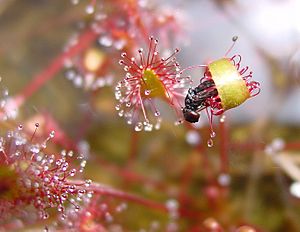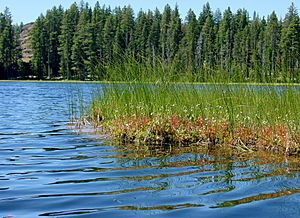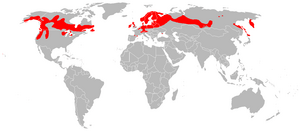English sundew facts for kids
Quick facts for kids English sundew |
|
|---|---|
 |
|
| Scientific classification | |
| Genus: |
Drosera
|
| Species: |
anglica
|
| Synonyms | |
|
List
|
|
Drosera anglica, also known as the English sundew or great sundew, is a fascinating carnivorous plant. It belongs to the sundew family, Droseraceae. This plant usually grows in temperate areas around the world. However, you can find it as far south as Japan, southern Europe, and even the island of Kauaʻi in Hawaiʻi. In these warmer places, it acts more like a subtropical sundew. Scientists believe D. anglica came from a special hybrid. It's thought to be a mix of two other sundew species, D. rotundifolia and D. linearis. This happened when a sterile hybrid plant doubled its chromosomes, making it fertile and stable.
Contents
Plant Features and Life Cycle
The English sundew is a perennial plant, meaning it lives for more than two years. It grows as an upright plant without a main stem. Its leaves form a circular pattern close to the ground, called a rosette. These leaves are long and narrow, shaped a bit like a spoon.
Like other sundews, the leaves are covered in tiny, stalked glands. These glands are reddish and have a clear, sticky liquid droplet at their tips. This sticky fluid is used to trap insects. Each leaf can be about 15 to 35 millimeters (0.6 to 1.4 inches) long. With its long stalk, the whole leaf can reach 30 to 95 millimeters (1.2 to 3.7 inches). The plants are usually green, but they turn red when they get a lot of sunlight.
In most places, D. anglica forms special winter buds called hibernacula. These are tight knots of curled leaves that stay at ground level. They help the plant survive the cold winter. In spring, when the dormancy period ends, these leaves unfurl. The plant's roots are quite weak and only go a few centimeters deep. They mainly help the plant stay in place and soak up water. Since the soil in bogs often lacks nitrogen, trapping insects gives the plant the nutrients it needs.
Flowers and Seeds
Drosera anglica blooms in the summer. It sends up flower stalks that are about 6 to 18 centimeters (2.4 to 7.1 inches) tall. Each stalk has several white flowers that open one at a time. Like other sundews, its flowers have five sepals (leaf-like parts), five petals, and five stamens (pollen-producing parts). They also have three styles (parts that receive pollen). The petals are 8 to 12 millimeters (0.3 to 0.5 inches) long.
These flowers don't have a smell or nectar, so they don't need insects to pollinate them. Instead, they pollinate themselves (autogamy), which means they produce seeds easily. The seeds are black, roundish, and spindle-shaped, about 1 to 1.5 millimeters long. The fruits are capsules that split open to release the seeds.
How it Catches Food
Like all sundews, D. anglica is a carnivorous plant. It uses its sticky glands, called tentacles, to catch and eat small arthropods, mostly insects. These glands cover the plant's leaves. Insects are drawn to the plant by a sweet smell coming from the glands. When an insect lands on the plant, it gets stuck in the sticky drops of fluid.
Most of the plant's prey are small insects like flies. However, it can also catch larger insects with big wings. Small butterflies, damselflies, and even dragonflies can get stuck in the plant's sticky goo.
When something touches the plant, the tentacles that are touching the prey start to move. This movement is called thigmotropism, which means movement in response to touch. The tentacles bend towards the prey and the center of the leaf. This helps to get as much contact as possible with the insect. D. anglica can also bend its entire leaf blade around the prey. This helps the plant digest its meal better. The tentacles can move in just a few minutes, but the whole leaf takes hours or even days to bend.
Once an insect is caught, the tentacles release even more sticky fluid. This traps the prey even more. The insect eventually dies from exhaustion or can't breathe because the sticky fluid blocks its breathing tubes (tracheae). After the plant has digested the prey and soaked up the nutrients, the leaf opens up again. Only the insect's hard outer shell (exoskeleton) is left behind.
Where it Lives
Drosera anglica likes to grow in open, non-forested areas. These places usually have wet soil that often contains a lot of calcium. You can find it in bogs, marl fens, quaking bogs, and other calcium-rich habitats. Being able to grow in calcium-rich soil is quite unusual for sundews.
This plant often grows with different kinds of sphagnum moss. Sometimes, the soil is made entirely of living or dead sphagnum moss. The sphagnum moss helps to bring moisture to the surface. It also makes the soil more acidic. Because of the constant moisture and low soil pH, there aren't many nutrients available in the soil. This means fewer other plants can grow there, which reduces competition. This allows the carnivorous English sundew to thrive.
Where it is Found Around the World
Drosera anglica is one of the most widespread sundews in the world. It is generally found in high-latitude areas around the globe, which is called circumboreal distribution. However, in some places, it grows much farther south. These areas include Japan, southern Europe, the Hawaiian island of Kauaʻi, and California.
The plants from Hawaiʻi are usually smaller than others. They also don't go through a winter dormancy period. In the United States, you can find D. anglica in 12 states, including Alaska. It also grows in 11 Canadian provinces and territories. It can grow at elevations from 5 meters (16 feet) up to at least 2000 meters (6,560 feet).
In Minnesota, USA, D. anglica was found in 1978. It was growing in shallow pools in peatlands. Because its populations are small and it needs specific microhabitats, it is listed as a threatened species in Minnesota.
How it Came to Be
Most North American Drosera species have 20 chromosomes (2n=20). But in 1955, a scientist named Wood noticed that D. anglica had 40 chromosomes (2n=40). He thought it might have come from a hybrid plant that doubled its chromosomes. This process is called amphidiploidy.
The leaves of D. anglica look like a mix between D. rotundifolia and D. linearis. These two species grow in the same areas in several places. So, Wood guessed that D. anglica probably came from a hybrid of these two plants.
All natural hybrids between North American Drosera species are usually sterile, meaning they can't produce seeds. For example, the natural hybrid D. rotundifolia × D. linearis is sterile. However, sometimes mistakes happen during the creation of egg and pollen cells. This can cause the chromosomes to double. When this happens, the plant can produce viable (able to grow) seeds. These resulting plants are called amphiploids, and they are fertile.
Wood believed that D. anglica was still forming from D. rotundifolia × D. linearis through this chromosome-doubling process in different places. It's interesting to wonder why D. anglica is found all over the world, while D. linearis is only found in the Great Lakes region of North America. One big reason might be that D. anglica can adapt to many different types of habitats.
History of its Discovery
Drosera anglica was first described by a botanist named William Hudson in 1778. For a long time, people often confused it with another sundew that has long leaves, D. intermedia. This confusion was made worse by an older name, D. longifolia, which was described by Carl Linnaeus in 1753. This name was not clear enough and was used for both D. anglica and D. intermedia. Even museum plant samples (herbarium specimens) were a mix of the two species.
Because of this confusion, Martin Cheek suggested in 1998 that the name D. longifolia should no longer be used. This suggestion was accepted, and the name was officially rejected in 1999.
Natural Hybrids
Several natural hybrids involving D. anglica exist. These are all sterile, meaning they cannot produce seeds. Here are some examples:
- D. anglica × capillaris = D. × anpil
- D. anglica × filiformis = D. × anfil
- D. anglica × linearis
- D. anglica × intermedia = D. × anterm
- D. anglica × spatulata = D. × nagamoto
- D. linearis × anglica = D. × linglica
- D. rotundifolia × anglica = D. × obovata
Besides these natural hybrids, people have also created several man-made hybrids.
Gallery
-
D. anglica growing in a mountain bog, British Columbia, Canada
See also
 In Spanish: Drosera anglica para niños
In Spanish: Drosera anglica para niños










